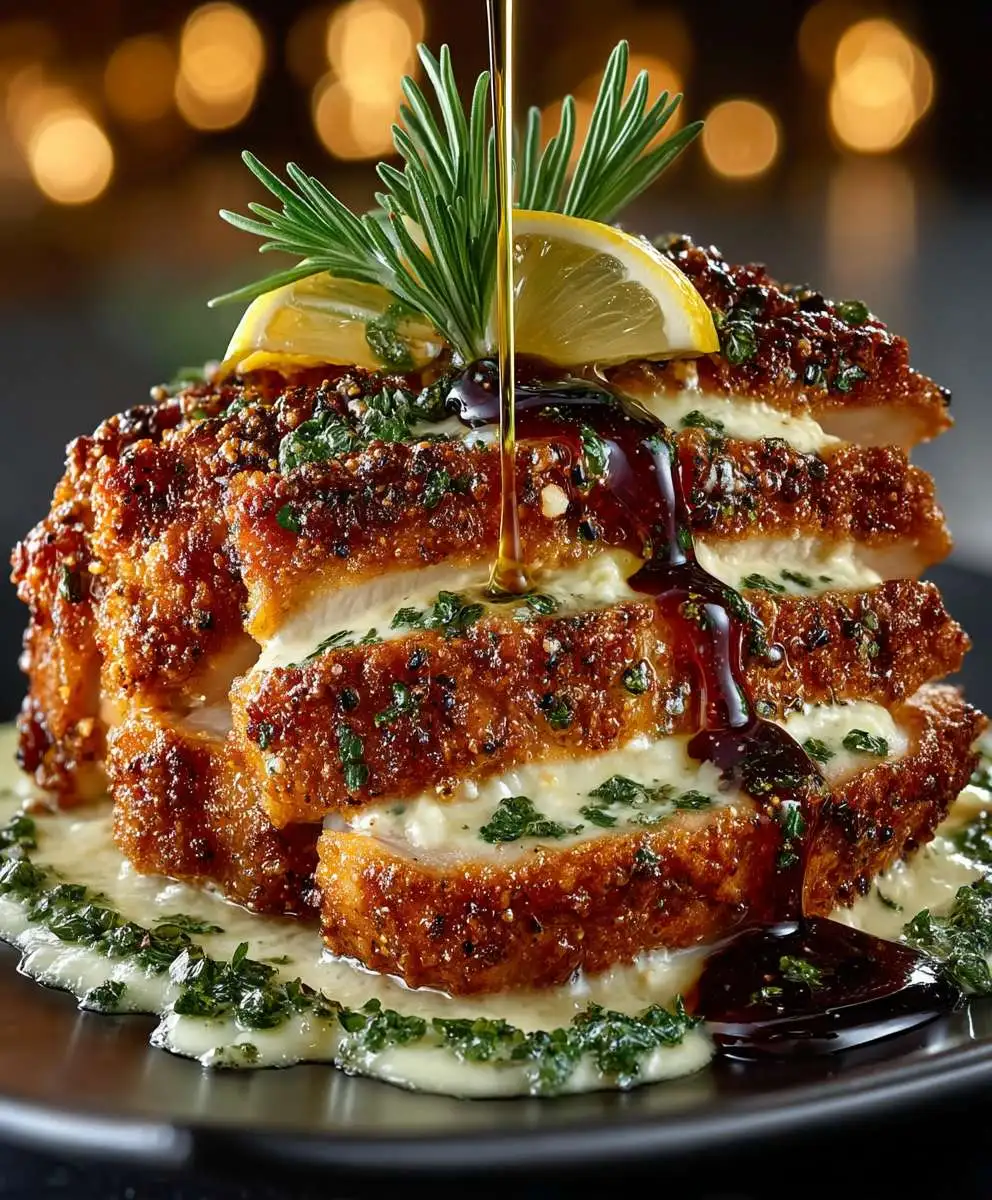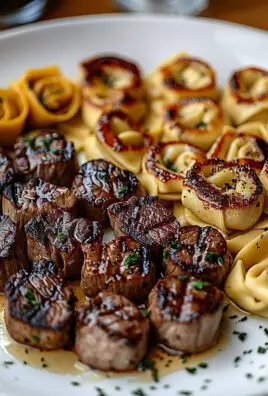Lemon Pecorino Chicken: Prepare to be amazed by this incredibly flavorful and surprisingly simple dish that will elevate your weeknight dinner game! Imagine succulent chicken breasts, pan-seared to golden perfection, then bathed in a bright, zesty lemon sauce, generously sprinkled with salty, nutty Pecorino Romano cheese. It’s a symphony of flavors that dances on your palate, leaving you craving more.
While the exact origins of Lemon Pecorino Chicken are somewhat shrouded in mystery, its Italian-inspired flavors hint at a rich culinary heritage. The combination of lemon and cheese is a classic pairing in Italian cuisine, often found in pasta dishes and other savory creations. Pecorino Romano, a hard, salty cheese made from sheep’s milk, adds a distinctive sharpness that perfectly complements the acidity of the lemon.
People adore this dish for several reasons. First and foremost, it’s incredibly delicious! The bright, tangy lemon sauce cuts through the richness of the chicken and cheese, creating a balanced and satisfying meal. Secondly, it’s remarkably easy to prepare. With just a handful of ingredients and a few simple steps, you can have a restaurant-quality dinner on the table in under 30 minutes. Finally, it’s a crowd-pleaser. Whether you’re cooking for your family or entertaining guests, Lemon Pecorino Chicken is sure to impress. So, let’s get cooking and discover the magic of this delightful dish!
Ingredients:
- For the Chicken:
- 4 boneless, skinless chicken breasts (about 6-8 ounces each)
- 1/2 cup all-purpose flour
- 1 teaspoon salt
- 1/2 teaspoon black pepper
- 1/4 teaspoon garlic powder
- 2 large eggs, lightly beaten
- 1/2 cup grated Pecorino Romano cheese, finely grated
- 1/4 cup olive oil
- 2 tablespoons butter
- For the Lemon Sauce:
- 1/4 cup dry white wine (such as Sauvignon Blanc or Pinot Grigio)
- 1/2 cup chicken broth
- 1/4 cup freshly squeezed lemon juice (from about 2 lemons)
- 2 tablespoons butter, cold and cubed
- 1 tablespoon chopped fresh parsley, for garnish
- 1 teaspoon lemon zest, for garnish
Preparing the Chicken:
- Pound the Chicken: Place each chicken breast between two sheets of plastic wrap. Using a meat mallet or rolling pin, pound the chicken to an even thickness of about 1/2 inch. This helps the chicken cook evenly and quickly. Don’t over-pound, you want it thin but not falling apart.
- Prepare the Dredging Station: In a shallow dish, combine the flour, salt, pepper, and garlic powder. Mix well with a fork. In a separate shallow dish, place the beaten eggs. In a third shallow dish, place the grated Pecorino Romano cheese.
- Dredge the Chicken: Take one chicken breast and dredge it in the flour mixture, making sure to coat it evenly on both sides. Shake off any excess flour. Next, dip the floured chicken into the beaten eggs, ensuring it’s fully coated. Finally, dredge the chicken in the grated Pecorino Romano cheese, pressing gently to help the cheese adhere to the chicken. Repeat this process with the remaining chicken breasts.
Cooking the Chicken:
- Heat the Oil and Butter: In a large skillet (preferably cast iron or stainless steel) over medium-high heat, heat the olive oil and butter until the butter is melted and the mixture is shimmering. The combination of oil and butter helps to prevent the butter from burning and adds richness to the dish.
- Cook the Chicken: Carefully place the dredged chicken breasts into the hot skillet, being careful not to overcrowd the pan. You may need to cook the chicken in batches to ensure even browning. Cook for about 4-5 minutes per side, or until the chicken is golden brown and cooked through. The internal temperature of the chicken should reach 165°F (74°C). Use a meat thermometer to check for doneness.
- Remove and Rest: Once the chicken is cooked through, remove it from the skillet and place it on a wire rack or a plate lined with paper towels to drain any excess oil. Let the chicken rest for a few minutes while you prepare the lemon sauce. This allows the juices to redistribute, resulting in a more tender and flavorful chicken.
Making the Lemon Sauce:
- Deglaze the Pan: After removing the chicken from the skillet, reduce the heat to medium. Pour the dry white wine into the skillet and use a wooden spoon to scrape up any browned bits from the bottom of the pan. These browned bits, called fond, are packed with flavor and will add depth to the sauce. Let the wine simmer for about 1-2 minutes, or until it has reduced slightly.
- Add Chicken Broth and Lemon Juice: Pour the chicken broth and freshly squeezed lemon juice into the skillet. Stir to combine. Bring the sauce to a simmer and let it cook for about 3-4 minutes, or until it has reduced slightly and thickened.
- Emulsify the Sauce: Remove the skillet from the heat. Whisk in the cold, cubed butter, one cube at a time, until the butter is fully melted and the sauce is smooth and emulsified. The cold butter helps to create a rich and creamy sauce. Be careful not to overheat the sauce at this stage, as it can cause the sauce to break.
- Season to Taste: Taste the lemon sauce and adjust the seasoning as needed. You may want to add a pinch of salt or pepper, or a squeeze of lemon juice, depending on your preference.
Assembling and Serving:
- Plate the Chicken: Place the cooked chicken breasts on a serving platter or individual plates.
- Spoon the Sauce: Spoon the lemon sauce generously over the chicken breasts. Make sure each piece of chicken is nicely coated with the flavorful sauce.
- Garnish and Serve: Garnish the chicken with chopped fresh parsley and lemon zest. Serve immediately. This dish pairs well with pasta, rice, roasted vegetables, or a simple salad.
Tips for Success:
- Use Fresh Ingredients: The best flavor comes from using fresh, high-quality ingredients. Freshly squeezed lemon juice and freshly grated Pecorino Romano cheese will make a noticeable difference in the taste of the dish.
- Don’t Overcook the Chicken: Overcooked chicken can be dry and tough. Use a meat thermometer to ensure the chicken is cooked to the correct internal temperature of 165°F (74°C).
- Adjust the Lemon Juice to Your Taste: The amount of lemon juice in the sauce can be adjusted to your preference. If you prefer a more tart sauce, add a little extra lemon juice. If you prefer a milder sauce, reduce the amount of lemon juice.
- Make it Ahead: You can prepare the chicken ahead of time and store it in the refrigerator until you’re ready to cook it. You can also make the lemon sauce ahead of time and reheat it gently before serving.
- Variations: Feel free to add other ingredients to the lemon sauce, such as capers, artichoke hearts, or sun-dried tomatoes. You can also use different types of cheese, such as Parmesan or Asiago.
Serving Suggestions:
- Pasta: Serve the Lemon Pecorino Chicken over your favorite pasta, such as linguine, spaghetti, or fettuccine. Toss the pasta with the lemon sauce for a complete and satisfying meal.
- Rice: Serve the chicken with a side of rice, such as white rice, brown rice, or risotto. The rice will soak up the delicious lemon sauce.
- Roasted Vegetables: Serve the chicken with roasted vegetables, such as asparagus, broccoli, or Brussels sprouts. The vegetables will provide a healthy and flavorful side dish.
- Salad: Serve the chicken with a simple salad, such as a green salad or a Caesar salad. The salad will provide a refreshing contrast to the rich and flavorful chicken.
- Bread: Serve the chicken with crusty bread for dipping in the lemon sauce.
Storing Leftovers:
- Refrigerate: Store leftover Lemon Pecorino Chicken in an airtight container in the refrigerator for up to 3-4 days.
- Reheat: Reheat the chicken gently in a skillet over medium heat or in the microwave. Be careful not to overcook the chicken, as it can become dry. You may want to add a little extra chicken broth or lemon juice to the skillet to keep the chicken moist.
- Freezing: While you can freeze this dish, the texture of the sauce may change slightly upon thawing. If you choose to freeze it, store the chicken and sauce separately in airtight containers. Thaw completely in the refrigerator before reheating.

Conclusion:
This Lemon Pecorino Chicken isn’t just another weeknight dinner; it’s a flavor explosion waiting to happen, and trust me, you absolutely need to experience it. The bright, zesty lemon perfectly complements the salty, nutty Pecorino Romano, creating a symphony of tastes that will tantalize your taste buds. The chicken itself, cooked to juicy perfection, becomes the perfect canvas for this incredible sauce. It’s quick, it’s easy, and it’s guaranteed to impress, even if you’re just impressing yourself!
But why is this recipe a must-try? Beyond the incredible flavor profile, it’s the sheer versatility. This isn’t a one-trick pony. It’s a recipe that can be adapted to your preferences and dietary needs. Feeling adventurous? Add a pinch of red pepper flakes for a subtle kick. Want to make it even richer? A knob of butter swirled into the sauce at the end will do the trick.
Serving Suggestions and Variations:
The possibilities are truly endless! Serve this Lemon Pecorino Chicken over a bed of creamy polenta for a comforting and satisfying meal. Or, toss it with your favorite pasta – linguine, fettuccine, or even penne would work beautifully. For a lighter option, serve it alongside a vibrant green salad or roasted asparagus.
Looking for variations? Swap out the Pecorino Romano for Parmesan cheese for a slightly milder flavor. Or, try using chicken thighs instead of breasts for a richer, more flavorful dish. You could even add some chopped artichoke hearts or sun-dried tomatoes to the sauce for an extra layer of complexity. If you’re watching your carb intake, consider serving it over cauliflower rice or zucchini noodles. The beauty of this recipe is that it’s incredibly forgiving and adaptable.
I’ve personally made this recipe countless times, and it’s always a hit. My family raves about it, and I often find myself making it for dinner parties because it’s so easy to prepare and always impresses my guests. The aroma alone is enough to make everyone’s mouth water!
Time to Get Cooking!
So, what are you waiting for? Grab your ingredients and get ready to create a culinary masterpiece. I promise you won’t be disappointed. This Lemon Pecorino Chicken is a game-changer, and I’m confident it will become a staple in your recipe repertoire.
I’m so excited for you to try this recipe and experience the magic for yourself. Once you do, I’d absolutely love to hear about your experience! Did you make any variations? What did you serve it with? What did your family think? Share your photos and stories in the comments below. Let’s create a community of Lemon Pecorino Chicken lovers! Your feedback is invaluable, and it helps me continue to create and share recipes that you’ll love. Happy cooking! I can’t wait to hear all about your culinary adventures with this delicious and easy Lemon Pecorino Chicken recipe.
Lemon Pecorino Chicken: A Delicious and Easy Recipe
Tender chicken breasts coated in Pecorino Romano cheese, pan-fried to golden perfection, and drizzled with a bright and creamy lemon sauce.
Ingredients
- 4 boneless, skinless chicken breasts (about 6-8 ounces each)
- 1/2 cup all-purpose flour
- 1 teaspoon salt
- 1/2 teaspoon black pepper
- 1/4 teaspoon garlic powder
- 2 large eggs, lightly beaten
- 1/2 cup grated Pecorino Romano cheese, finely grated
- 1/4 cup olive oil
- 2 tablespoons butter
- 1/4 cup dry white wine (such as Sauvignon Blanc or Pinot Grigio)
- 1/2 cup chicken broth
- 1/4 cup freshly squeezed lemon juice (from about 2 lemons)
- 2 tablespoons butter, cold and cubed
- 1 tablespoon chopped fresh parsley, for garnish
- 1 teaspoon lemon zest, for garnish
Instructions
- Pound the Chicken: Place each chicken breast between two sheets of plastic wrap. Using a meat mallet or rolling pin, pound the chicken to an even thickness of about 1/2 inch.
- Prepare the Dredging Station: In a shallow dish, combine the flour, salt, pepper, and garlic powder. In a separate shallow dish, place the beaten eggs. In a third shallow dish, place the grated Pecorino Romano cheese.
- Dredge the Chicken: Dredge each chicken breast in the flour mixture, then the beaten eggs, and finally the grated Pecorino Romano cheese, pressing gently to adhere.
- Heat the Oil and Butter: In a large skillet over medium-high heat, heat the olive oil and butter until the butter is melted and shimmering.
- Cook the Chicken: Carefully place the dredged chicken breasts into the hot skillet, being careful not to overcrowd the pan. Cook for about 4-5 minutes per side, or until golden brown and cooked through (internal temperature of 165°F/74°C).
- Remove and Rest: Remove the chicken from the skillet and place it on a wire rack or a plate lined with paper towels to drain any excess oil. Let the chicken rest for a few minutes.
- Deglaze the Pan: Reduce the heat to medium. Pour the dry white wine into the skillet and scrape up any browned bits from the bottom of the pan. Let the wine simmer for about 1-2 minutes, or until it has reduced slightly.
- Add Chicken Broth and Lemon Juice: Pour the chicken broth and freshly squeezed lemon juice into the skillet. Stir to combine. Bring the sauce to a simmer and let it cook for about 3-4 minutes, or until it has reduced slightly and thickened.
- Emulsify the Sauce: Remove the skillet from the heat. Whisk in the cold, cubed butter, one cube at a time, until the butter is fully melted and the sauce is smooth and emulsified.
- Season to Taste: Taste the lemon sauce and adjust the seasoning as needed.
- Plate the Chicken: Place the cooked chicken breasts on a serving platter or individual plates.
- Spoon the Sauce: Spoon the lemon sauce generously over the chicken breasts.
- Garnish and Serve: Garnish the chicken with chopped fresh parsley and lemon zest. Serve immediately.
Notes
- Use fresh, high-quality ingredients for the best flavor.
- Don’t overcook the chicken; use a meat thermometer to ensure it reaches 165°F (74°C).
- Adjust the amount of lemon juice in the sauce to your preference.
- You can prepare the chicken ahead of time and store it in the refrigerator until you’re ready to cook it. You can also make the lemon sauce ahead of time and reheat it gently before serving.
- Feel free to add other ingredients to the lemon sauce, such as capers, artichoke hearts, or sun-dried tomatoes. You can also use different types of cheese, such as Parmesan or Asiago.




